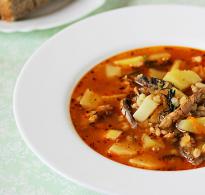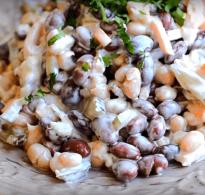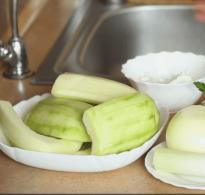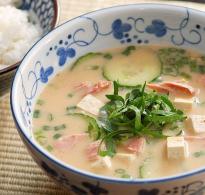Beef steak with red wine sauce. How to cook breaded beef steak
The history of steak, like most dishes of modern European cuisine, began in Ancient Rome. There, during the Saturnalia festivals, huge grates were installed on the altars in the temples, with coals poured under them. Huge pieces of beef were placed on the grates. The smoke rising to the sky was considered the food of the gods, and the fried meat was distributed to the people.
In medieval times, steaks were considered the food of the poor - beef was considered “old”, cheap meat, while the aristocracy preferred veal. Beef was rehabilitated in England in the 16th century - when they began to fatten bulls exclusively for meat. Over time, this practice spread throughout Europe, and the priority of England was recorded in the very name of the dish, which is a piece of beef roasted over an open fire - “beefsteak”, later shortened to the simple and biting “steak”.
Cattle were brought to America at the end of the 15th century by Christopher Columbus, but it took almost 200 years, plus the active colonization of the New World by the British, for the marbled beef steak that is famous and valued by meat eaters all over the world to appear. Today, the main suppliers of meat for steaks are Argentina and Australia, where elite livestock farming is highly developed.
We offer you beef steak recipes that you can easily prepare at home. In addition, on the site delicious recipes http://vkusnoe.biz/ you can find original recipes preparing meat dishes.

Juicy beef steak with oranges
- 1 kg beef steak
- 2 oranges
- 2 cloves garlic
- 1 tsp grated ginger root
- 1 tbsp vegetable oil
Cooking beef steak
Squeeze the juice from 1 orange. Finely chop the ginger and garlic. Mix the juice with garlic and ginger. Pour the juice with spices onto the meat and leave to marinate for 8 hours. Preheat the grill or grill pan and grease the grate with oil. Grill the steaks for 10 minutes. from each side. Squeeze the juice from the second orange and heat it. Cut the finished steaks into pieces and pour over the juice.

Beef steak in a frying pan
- 1 kg beef steak
- 1 tbsp olive oil
- 1/2 tsp ground black pepper
- 1/2 tsp thyme
- 1 lemon
How to Grill Beef Steak
Mix the oil with seasonings and rub the mixture over the steaks. Heat the pan and fry the steaks for 15 minutes. from each side. At the end of frying, sprinkle the steaks with salt. Cut the lemon into pieces and serve with the finished dish.

Beef steak in red wine
- 750 g beef steak
- 250 ml red wine
- 2 tsp garlic salt
- 1 tbsp dried oregano
- ground black pepper
Cooking beef steak in red wine
Cut the steak into large portions. Separate the meat from excess fat and veins. Mix wine, salt, oregano and pepper. Place the meat in a shallow non-metallic bowl, pour in the marinade, cover and refrigerate for several hours or overnight. Grill the steaks on a hot grill for 3-4 minutes. on each side or until desired degree of doneness, brushing constantly with wine mixture.

Breaded beef steak in a frying pan
- 10 pieces of thin beef steak
- 75 ml vegetable oil
- 30 ml vinegar
- 1 tbsp dried oregano
- 1 tbsp dried parsley
- 1 egg
- breadcrumbs
- pepper
How to cook breaded beef steak
In a bowl, mix vinegar, herbs, spices and egg. Pour the mixture over the meat and marinate for 2 hours. Grease the frying pan with oil. Roll the meat in breadcrumbs and place in a frying pan. Fry on both sides until golden brown.
Bon appetit!
I won’t say anything, just meat, such a delicious piece of meat
As an option, here you can see another version of steaks, this time Caucasian. They were prepared from the same batch of meat, but when they came out they were completely different, the wine had a more delicate taste, but the “Caucasian” ones came out juicier and hotter :)
Ingredients:
6 (1,200 kg) pork steaks
1 bottle of dry wine
1 onion
salt, pepper mixture
1 tbsp. olive oil
Preparation:

We recommend: Salmon steak. 
If you need to cook something simple and tasty dish with a certain pretense of sophistication, you still won’t find a better candidate than salmon steak. This time, I’m not lying about the “simple” thing - even a textbook bearded system administrator in a sweater, who has never cooked anything more complex than dumplings, and then suddenly decided to arrange for his girlfriend, can cope with the task. romantic evening by candlelight. I discovered the combination of salmon with a side dish of root vegetables in Finland, but you can prepare any other side dish, for example, mashed potatoes. Salmon steak with glazed vegetables
2 salmon steaks weighing 250-300 g each
for garnish:
root vegetables (eg 1 beet and 2 carrots)
1.5 tbsp. Sahara
1 tbsp. butter
If you have another idea for a side dish, skip straight to the next paragraph. Otherwise, peel the root vegetables (I take the simplest option, but if you can get Jerusalem artichokes, parsnips, etc., that would be great) and cut into small pieces (ideally, of course, balls - it’s beautiful). Melt the butter in a small saucepan, fry the root vegetables in it, add sugar (preferably brown) or honey, and stir. Then add water or broth so that the vegetables are completely covered, and cook under the lid until half cooked. After this, remove the lid and reduce the syrup thoroughly so that all the glaze remains on the vegetables. If you took beets, for obvious reasons they should be boiled separately from other vegetables.
Everything is simpler with fish. I like to grill steak or... regular frying pan and then finish cooking in the oven. To do this, sprinkle the steaks with lemon juice, season with salt and pepper, and fry in an oiled grill pan for one minute on each side (alternatively, in a small amount of olive oil in a regular frying pan). Then transfer the steaks to a baking dish and place in the oven, preheated to 180 degrees, for 7-10 minutes, until the desired condition is achieved (I like the salmon to still be a little orange inside, so I focus on the lower threshold). A sauce that goes well with fish, for example, is yogurt, dill, tarragon, lemon juice, olive oil, salt pepper.
I won’t say anything, just meat, such a delicious piece of meat
As an option, here you can see another version of steaks, this time Caucasian. They were prepared from the same batch of meat, but when they came out they were completely different, the wine had a more delicate taste, but the “Caucasian” ones came out juicier and hotter :)
Ingredients:
6 (1,200 kg) pork steaks
1 bottle of dry wine
1 onion
salt, pepper mixture
1 tbsp. olive oil
Preparation:

Everyone famous dish- an omelette, some know how to cook it, but for some it never turns out smooth, tasty and airy. After all, at first glance, it seems like a simple dish that can be prepared according to the recipe. But no - the dish is complex and “insidious”, because you will achieve a “lush effect” if you follow the exact recipe. We invite you to try an omelet recipe that you will love delicate taste, aroma and beautiful appearance.
You will need:
- Eggs – 2 pieces;
- Milk – 2 glasses (2 glasses of 250 grams each);
- Butter – 20 grams;
- Flour – 2 tablespoons;
- Salt – 1 teaspoon.
Preparation:
1. Beat the eggs with a mixer until fluffy.
2. Add salt and milk, then beat again with a mixer.
3. Pour flour into the resulting mixture and stir with a whisk until smooth.
4. Put butter into the pan and melt it. Pour the omelette into it and cook it for 15 minutes over low heat, covering it with a lid. When cooked, the omelette will “puff up” in the middle and become very fluffy. You can experiment with making omelettes. Many people cook it with various fillings and it has many variations. The filling can be ham, cheese, mushrooms, herbs, tomatoes, or powdered sugar.
Also, if you want to remember the “taste of childhood” - a kindergarten omelette, then you need to pour it into a greased high frying pan and bake in a preheated oven for about 20 - 25 minutes at a temperature of 200 degrees. You'd better double the portion because this omelet is a blast. Do not open the oven when baking. The omelette rises well, however, when you take it out of the oven, it will sag a little - this is normal.
Kindergarten omelet
The best accompaniment to meat is red wine - this elementary truth is known even to people far from cooking. This wonderful union truly has an indestructible magical harmony. However, as in any relationship, main role nuances play.
Simple truths
The successful compatibility of red wine and meat is explained by the deep chemistry of feelings. The fact is that red wine contains tannin, a substance produced by the skin of the grapes. This valuable element
neutralizes the effect of fats, which are so rich in red meat, which is why these two products have mutual sympathy for each other.
To learn how to create winning combinations from specific meat dishes and wines, you need to remember a few simple truths. The simplest rule is to combine dishes and drinks from the same region. Thus, a steak made from selected Argentine beef requires addition in the form of dry red Malbec from the same Argentina. But since difficulties may arise with the geographical factor, it is easier to combine meat and wine according to the principle of balancing flavors. They need to be selected in such a way that they either “sound in unison” or, conversely, emphasize each other’s taste differences. For example, to aromatic meat dishes Wines with a bright, rich bouquet are suitable. And if there is sourness in the meat, it is better to balance it with soft, sweet wine.
When creating the perfect pair, it is worth considering not only the taste of the main ingredients, but also the secondary components - spices and sauces. Overly complex seasonings can transform the taste familiar products beyond recognition and bring new accents to the fore. In this case, the wine is no longer matched to the dish itself, but to the sauce or seasoning.
A pair for each meat

Most often, the choice of wine is dictated by the type of meat from which a particular dish is prepared. Steak from marbled beef has many layers of fat, thanks to which the meat comes out during frying delicious juice. Argentinean, Chilean, French wines from Bordeaux, as well as Californian Cabernet, can harmoniously complement such a dish. To more tender steak Chateaubriand is best suited to a wine with a soft and mature taste, such as New Zealand Pinot Noir, Australian Shiraz or Burgundy Chambertin.
Lamb meat is tender and at the same time rich in fat. Therefore, he needs to choose a wine to pair with that is soft, but not too rich. South African Pinotage and Pinot Noir from the fertile lands of Burgundy will taste organically with such meat. French Sauvignon or Merlot wines with a dense flavor and bright notes of black currant pair well with stewed red meat and juicy roast lamb.
Pork is classified as white meat, therefore the most are allowed here different variations, with both red and white wine. Smoky grilled pork harmonizes with dense red varieties - Barbaresco, Chianti, and Bordeaux wines. But roast pork with vegetables is perfectly complemented by white wines - Riesling, Viognier or Gruner. Whole baked pork has a much more refined and delicate taste. Dry white wines Chardonnay and Riesling highlight it most clearly. By the way, red wine is quite appropriate for this dish, although it may dominate. In order not to destroy the fragile harmony of tastes, it is best to take a bottle of Pinot Noir or Beaujolais.
Laconic meat snacks are also capable of creating winning tandems with wine. Since these dishes open the meal, it is better to choose unsaturated and light wines with them. Shiraz with appetizing notes of spices matches various smoked meats and sausages. A meat pates goes well with white semi-dry wines.
Meat with a wild character

Some gourmets gravitate towards more specific game. This meat is extremely tough and dry, and also has a characteristic aroma. Most often, game dishes are served in combination with bright berry sauces. To balance this complex taste, you should choose light wines, and also take into account individual characteristics different varieties meat.
Roasted wild boar goes best with classic Chianti, stewed wild boar goes best with French wines Fitu and Bandol. A harmonious addition to fried venison will be Pinot Noir, as well as red Burgundy wines. Grilled venison goes well with Syrah. Dense Spanish varieties from Ribera del Duero, as well as French Cabernet Sauvignon and Merlot can be safely served with roast venison.
Partridge prefers rich, fruity wines, but not too strong. A wild duck recognizes drinks with a pronounced aroma and a spicy aftertaste, so Australian Shiraz, Chilean Carménère and wines from Priorat will appeal to her. If you are planning to cook roast pheasant or black grouse, in addition to these dishes you should choose soft Spanish Navarro or velvety French Pinot Noir. However, in this case, you should pay close attention to the spices - excessive piquancy will mercilessly overshadow the subtle flavors.
The art of pairing wine and meat does not oblige you to adhere to strict rules, but rather some general recommendations. By skillfully combining them with your own preferences, you can discover many unexpected tastes even in the most familiar dishes.
1. In a well-heated frying pan, lightly fry black pepper, coriander seeds, fennel seeds, chili and bay leaves. After this, pour the spices into a mortar and lightly crush with a pestle, without trying to turn it into powder.
2. Pour the resulting mixture into a deep bowl. Pour wine, olive oil, Worcestershire sauce there, add crushed garlic, rosemary, mix everything.
3. Place the meat in this bowl and place it in the refrigerator. It is recommended to marinate for a day, but you can also marinate for half a day.
4. An hour before frying, remove the meat from the refrigerator and pat dry on a paper towel.
5. Pour the remaining marinade into a saucepan and simmer over low heat for 25 minutes.
6. The meat should be fried on a well-heated grill for about 7 minutes on each side. After this, wrap in foil and leave for 10 minutes.
7. Serve with half-reduced marinade sauce.
Recipe simple marinade from Afisha Eda.






